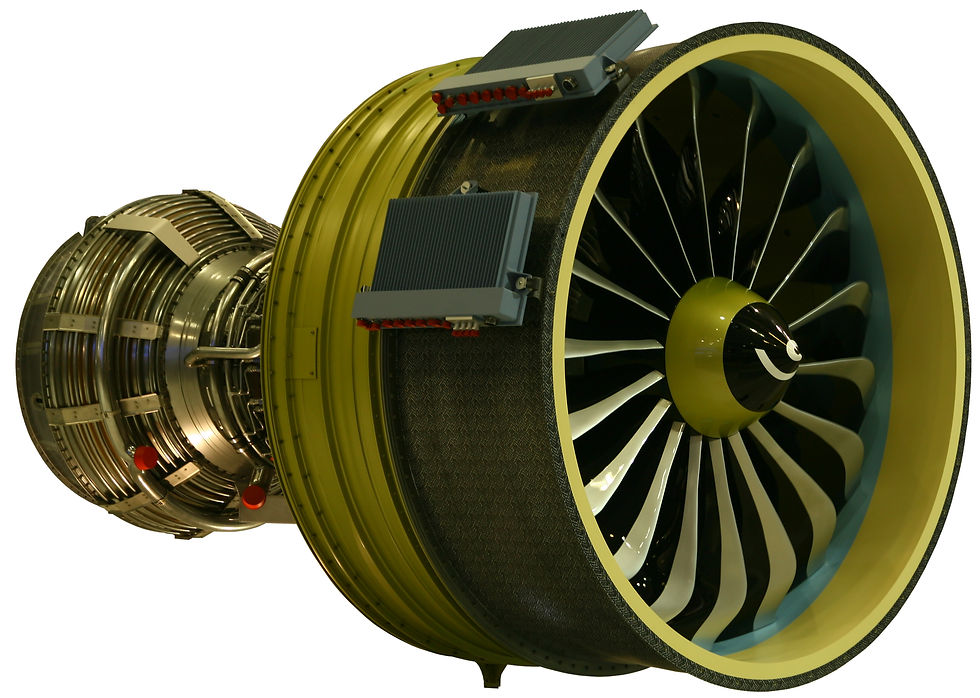CFM International LEAP
- Joseph Thaipparambil

- Feb 20, 2019
- 2 min read
The CFM International LEAP is a high-bypass turbofan engine. It is produced by CFM International, a 50-50 Franco-American joint venture company between GE Aviation of the United States and Safran Aircraft Engines (formerly known as Snecma) of France. It is a modernized complement to the successful CFM56, intended to compete with the Pratt & Whitney PW1000G in the single-aisle jetliner market. CFM intends to replace the CFM56 with the LEAP.

Design
The LEAP's basic architecture includes a scaled-down version of Safran's low pressure turbine used on the GEnx engine. The fan has flexible blades manufactured by a resin transfer molding process, which are designed to untwist as the fan's rotational speed increases. While the LEAP is designed to operate at a higher pressure than the CFM56 (which is partly why it is more efficient), GE plans to set the operating pressure lower than the maximum in order to maximize the engine's service life and reliability.
Currently proposed for the LEAP is a greater use of composite materials, a blisk fan in the compressor, a second-generation Twin Annular Pre-mixing Swirler (TAPS II) combustor, and a bypass ratio around 10-11:1.
GE is using ceramic matrix composites (CMC) to build the turbine shrouds.These technological advances are projected to produce 16% lower fuel consumption.Reliability is also supported by use of an eductor-based oil cooling system similar to that of the GEnx, featuring coolers mounted on the inner lining of the fan duct.

Development
The LEAP ("Leading Edge Aviation Propulsion")incorporates technologies that CFM developed as part of the LEAP56 technology acquisition program, which CFM launched in 2005.The engine was officially launched as LEAP-X on 13 July 2008.[8] It is intended to be a successor to the CFM56-5B and CFM56-7B. In 2009, Commercial Aircraft Corporation of China Ltd (COMAC) choose the LEAP engine for the C919. In total, 28 test engines will be used by CFM to achieve engine certification, and 32 others will be used by Airbus, Boeing and COMAC for aircraft certification and test programs.
The first engine entering the test program successfully reached and sustained 33,000 lbf (150 kN) of thrust, required to satisfy the highest rating for the Airbus A321neo. The same engine ultimately reached 35,000 lbf (160 kN) of thrust in test runs.
General Electric carried out the first test flight, of a LEAP-1C, in Victorville, California, with the engine mounted on the company's Boeing 747 flying testbed, on October 6, 2014. The -1C version features a thrust reverser equipped with a one piece O-ring replacing a 2 piece door. The thrust reverser is deployed by the O-ring sliding aft, reducing the drag that was induced by the older design and improving efficiency.
In April 2015, it was reported that the LEAP-1B was suffering up to a 5% shortfall on its promised reduction in fuel consumption. It obtained its 180-minute ETOPS approval from the U.S. Federal Aviation Authority and the European Aviation Safety Agency on June 19, 2017.

=============================================================
Applications
CFM international Leap Engine
Model Application Thrust range Introduction
1A Airbus A320neo family 24,500–35,000 lbf (109–156 kN) 2 Aug 2016
1B Boeing 737 MAX 23,000–28,000 lbf (100–120 kN) 22 May 2017
1C COMAC C919 27,980–30,000 lbf (124.5–133.4 kN 2021
=============================================================
Source : Wikipedia



Comments